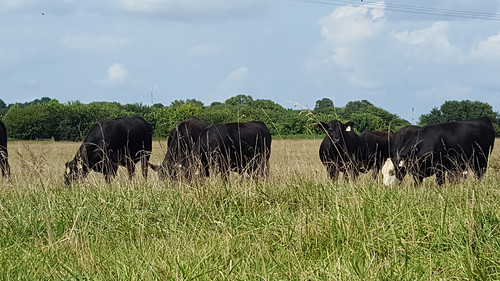Stockpiling fescue way for extending grazing season
By Mary Hightower
U of A System Division of Agriculture
Aug. 24, 2017
Fast facts
- Summer is the time to think about winter forage
- Stockpiling enables ranchers to make most of cool-season forage
(322 words)
(Download this story in MS Word here.)
(Newsrooms – with downloadable art at www.flickr.com/photos/uacescomm/36520723861, www.flickr.com/photos/uacescomm/35849755733)
FAYETTEVILLE, Ark. – It’s still summer, but now is the time to be thinking about stockpiling forage for the winter, said Dirk Philipp, associate professor-animal science, for the University of Arkansas System Division of Agriculture
Stockpiling is the practice of accumulating forage growth for later use, he said.
“Stockpiling is done later in the season to take advantage of cooler days to reduce fiber accumulation and promote leaf growth,” Philipp said. ”Stockpiling can also save money from not having to harvest hay but let cattle graze standing forage instead.”
Philipp said the first step is to select a field for stockpiling and remove the existing stubble height to 3-4 inches.
“This can be done with either grazing or haying at the appropriate times so that you can start out with that canopy height,” he said.
However, “if you experienced a very hot summer, it is possible that the fescue is brown and dormant,” he said. “In this case, it is possible to bush hog the stand to open up the canopy for growth and cut down on dead leaf material, although grazing or haying is preferred.”
Philipp recommends fertilizing with 60 pounds of nitrogen per acre on or near Sept. 1.
“Don’t wait for rain,” he said. “Once fertilized defer grazing until November mid-November.”
He also recommends soil sampling on a regular basis to get a handle on what nutrients are missing or in only limited quantities in the soil.
Grazing management
Once November rolls around and the stockpile is ready to be grazed, Philipp recommends using strip grazing to help stretch the forage to February.
“Run a poly wire across the stockpiled field so that animals have access to just two to three days of forage at a time,” he said. “This way you make the most efficient use of the stockpiled fescue without wasting it.”
For more information about livestock and forage management, contact your county extension agent or visit www.uaex.uada.edu.
About the Division of Agriculture
The University of Arkansas System Division of Agriculture’s mission is to strengthen agriculture, communities, and families by connecting trusted research to the adoption of best practices. Through the Agricultural Experiment Station and the Cooperative Extension Service, the Division of Agriculture conducts research and extension work within the nation’s historic land grant education system.
The University of Arkansas System Division of Agriculture is an equal opportunity institution. If you require a reasonable accommodation to participate or need materials in another format, please contact the SW Research and Extension Center at 870-777-9702 as soon as possible. Dial 711 for Arkansas Relay.
# # #
Media Contact: Mary Hightower
Dir. of Communication Services
U of A System Division of Agriculture
Cooperative Extension Service
(501) 671-2126
mhightower@uada.edu
Related Links
